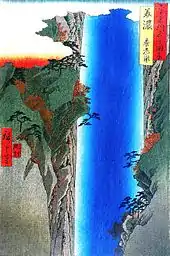Woodblock printing
Woodblock printing or block printing is a technique for printing text, images or patterns used widely throughout East Asia and originating in China in antiquity as a method of printing on textiles and later paper. As a method of printing on cloth, the earliest surviving examples from China date to before 220 AD. Woodblock printing existed in Tang China by the 7th century AD and remained the most common East Asian method of printing books and other texts, as well as images, until the 19th century. Ukiyo-e is the best-known type of Japanese woodblock art print. Most European uses of the technique for printing images on paper are covered by the art term woodcut, except for the block-books produced mainly in the 15th century.

| Part of a series on the | ||||||||||||||||||||||||||||||||||||||||||||||||||||||
| History of printing | ||||||||||||||||||||||||||||||||||||||||||||||||||||||
|---|---|---|---|---|---|---|---|---|---|---|---|---|---|---|---|---|---|---|---|---|---|---|---|---|---|---|---|---|---|---|---|---|---|---|---|---|---|---|---|---|---|---|---|---|---|---|---|---|---|---|---|---|---|---|
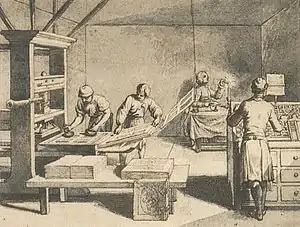 | ||||||||||||||||||||||||||||||||||||||||||||||||||||||
|
||||||||||||||||||||||||||||||||||||||||||||||||||||||
Seals and stamps
Prior to the invention of woodblock printing, seals and stamps were used for making impressions. The oldest of these seals came from Mesopotamia and Egypt. The use of round "cylinder seals" for rolling an impress onto clay tablets goes back to early Mesopotamian civilization before 3000 BC, where they are the most common works of art to survive, and feature complex and beautiful images. A few much larger brick (e.g. 13×13 cm) stamps for marking clay bricks survive from Akkad from around 2270 BC.[1] There are also Roman lead pipe inscriptions of some length that were stamped, and amulet MS 5236 may be a unique surviving gold foil sheet stamped with an amulet text in the 6th century BC. Both the Bronze Age Phaistos Disc and the medieval Prüfening dedicatory inscription appear to have been stamped using a similar method with reusable characters, and have been cited as early examples of movable type printing. However none of these used ink, which is necessary for printing (on a proper definition), but stamped marks into relatively soft materials. In both China and Egypt, the use of small stamps for seals preceded the use of larger blocks. In Europe and India, the printing of cloth certainly preceded the printing of paper or papyrus; this was probably also the case in China. The process is essentially the same—in Europe special presentation impressions of prints were often printed on silk until at least the 17th century.
Technique

The wood block is carefully prepared as a relief pattern, which means the areas to show 'white' are cut away with a knife, chisel, or sandpaper leaving the characters or image to show in 'black' at the original surface level. The block was cut along the grain of the wood. It is necessary only to ink the block and bring it into firm and even contact with the paper or cloth to achieve an acceptable print. The content would of course print "in reverse" or mirror-image, a further complication when text was involved. The art of carving the woodcut is technically known as xylography, though the term is rarely used in English.
For colour printing, multiple blocks are used, each for one colour, although overprinting two colours may produce further colours on the print. The paper is normally keyed to a frame around the woodblocks.
There are three methods of printing to consider:
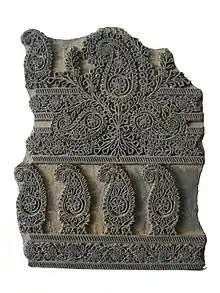
- Stamping
- Used for many fabrics, and most early European woodcuts (1400–40). These items were printed by putting paper or fabric on a table or a flat surface with the block on top, and pressing, or hammering, the back of the block.
- Rubbing
- The most common for Far Eastern printing. Used for European woodcuts and block-books later in the 15th century, and very widely for cloth. The block is placed face side up on a table, with the paper or fabric on top. The back of the paper or fabric is rubbed with a "hard pad, a flat piece of wood, a burnisher, or a leather frotton".[2]
- Printing in a press
- "Presses" only seem to have been used in Asia in relatively recent times. Simple weighted presses may have been used in Europe, but firm evidence is lacking. Later, printing-presses were used (from about 1480). A deceased Abbess of Mechelen in Flanders in 1465 had "unum instrumentum ad imprintendum scripturas et ymagines ... cum 14 aliis lapideis printis" ("an instrument for printing texts and pictures ... with 14 stones for printing") which is probably too early to be a Gutenberg-type printing press in that location.[2]
In addition, jia xie is a method for dyeing textiles (usually silk) using wood blocks invented in the 5th–6th centuries in China. An upper and a lower block are made, with carved out compartments opening to the back, fitted with plugs. The cloth, usually folded a number of times, is inserted and clamped between the two blocks. By unplugging the different compartments and filling them with dyes of different colours, a multi-coloured pattern can be printed over quite a large area of folded cloth. The method is not strictly printing however, as the pattern is not caused by pressure against the block.[3]
Colour woodblock printing
The earliest woodblock printing known is in colour—Chinese silk from the Han dynasty printed in three colours.[3] On paper, European woodcut prints with coloured blocks were invented in Germany in 1508 and are known as chiaroscuro woodcuts.
Colour is very common in Asian woodblock printing on paper; in China the first known example is a Diamond sutra of 1341, printed in black and red at the Zifu Temple in modern-day Hubei province. The earliest dated book printed in more than 2 colours is Chengshi moyuan (Chinese: 程氏墨苑), a book on ink-cakes printed in 1606 and the technique reached its height in books on art published in the first half of the 17th century. Notable examples are the Hu Zhengyan's Treatise on the Paintings and Writings of the Ten Bamboo Studio of 1633,[4] and the Mustard Seed Garden Painting Manual published in 1679 and 1701.[5]
In Japan, a multi-colour technique called nishiki-e ("brocade pictures") spread more widely, and was used for prints from the 1760s on. Japanese woodcut became a major artistic form, although at the time it was accorded a much lower status than painting.
In both Europe and Japan, book illustrations were normally printed in black ink only, and colour reserved for individual artistic prints. In China, the reverse was true, and colour printing was used mainly in books on art and erotica.
History
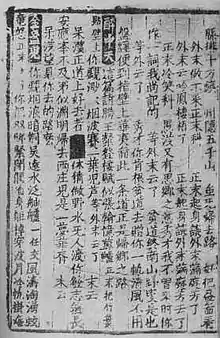
Origins in Asia
The earliest woodblock printed fragments to survive are from China and are of silk, printed with flowers in three colours from the Han dynasty (before AD 220).[3] It is clear that woodblock printing developed in Asia several centuries before Europe. The Chinese were the first to use the process to print solid text, and equally that, much later, in Europe the printing of images on cloth developed into the printing of images on paper (woodcuts). It is also now established that the use in Europe of the same process to print substantial amounts of text together with images in block-books only came about four hundred years after the development of movable type by Bi Sheng (990–1051) during the Northern Song Dynasty of China.
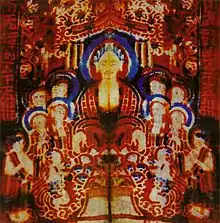
In China, an alternative to woodblock printing was a system of reprography since the Han Dynasty using carved stone steles to reproduce pages of text.[6] The three necessary components for woodblock printing are the wood block, which carries the design cut in relief; dye or ink, which had been widely used in the ancient world; and either cloth or paper, which was first developed in China, around the 3rd century BC or 2nd century BC. It seems that woodblock printing on papyrus has never been practised, although it would be possible.
A few specimen of wood block printing, possibly called tarsh in Arabic,[7] have been excavated from a 10th-century context in Arabic Egypt. They were mostly used for prayers and amulets. The technique may be spread from China or an independent invention,[8] but had very little impact and virtually disappeared at the end of the 14th century.[9] In India the main importance of the technique has always been as a method of printing textiles, which has been a large industry since at least the 10th century.[10] Large quantities of printed Indian silk and cotton were exported to Europe throughout the Modern period.
Because Chinese has a character set running into the thousands, woodblock printing suits it better than movable type to the extent that characters only need to be created as they occur in the text. Although the Chinese had invented a form of movable type with baked clay in the 11th century, and metal movable type was invented in Korea in the 13th century,[11] woodblocks continued to be preferred owing to the formidable challenges of typesetting Chinese text with its 40,000 or more characters. Also, the objective of printing in the East may have been more focused on standardization of ritual text (such as the Buddhist canon Tripitaka, requiring 80,000 woodblocks), and the purity of validated woodblocks could be maintained for centuries.[12] When there was a need for the reproduction of a text, the original block could simply be brought out again, while moveable type necessitated error-prone composition of distinct "editions".
In East Asia, the state involved itself in printing at a relatively early stage; initially only the government had the resources to finance the carving of the blocks for long works. The difference between East Asian woodblock printing and the Western printing press had major implications for the development of book culture and book markets in East Asia and Europe.
Early printed books in China and Korea
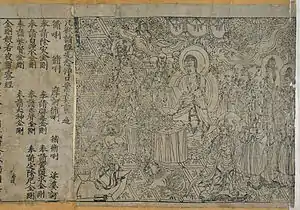
Woodblock printing in China is strongly associated with Buddhism, which encouraged the spread of charms and sutras. In the Tang Dynasty, a Chinese writer named Fenzhi first mentioned in his book "Yuan Xian San Ji" that the woodblock was used to print Buddhist scriptures during the Zhenguan years (AD 627~649).
The oldest existing print done with wood-blocks was discovered in 1974 in an excavation in Xi'an (the capital of Tang-Dynasty China, then called Chang'an), Shaanxi, China, whereby individual sheets of paper were pressed into wooden blocks with the text and illustrations carved into them.[13] It is a dharani sutra printed on hemp paper and dated to 650 to 670 AD, during the Tang Dynasty (618–907).[13] Another printed document dating to the early half of the Chinese Tang Dynasty has also been found, the Saddharma pundarika sutra printed from 690 to 699.[13]
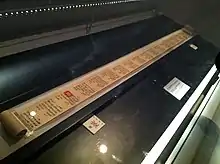
An early example of woodblock printing on paper is The Great Dharani Sutra that is dated between AD 704 and 751. It was found at Bulguksa, South Korea in 1966.[14] Its Buddhist text was printed on a 8 cm × 630 cm (3.1 in × 248.0 in) mulberry paper scroll in the early Korean Kingdom of Unified Silla. Another version of the Dharani sutra, printed in Japan around AD 770, is also frequently cited as an example of early printing. One million copies of the sutra, along with other prayers, were ordered to be produced by Empress Shōtoku. As each copy was then stored in a tiny wooden pagoda, the copies are together known as the Hyakumantō Darani (百万塔陀羅尼, "1,000,000 towers/pagodas Darani").
The world's earliest dated (AD 868) printed book is a Chinese scroll about sixteen feet long containing the text of the Diamond Sutra. It was found in 1907 by the archaeologist Sir Marc Aurel Stein in the Mogao Caves of Dunhuang, and is currently in the possession of the British Library. The book displays a great maturity of design and layout and speaks of a considerable ancestry for woodblock printing. The colophon, at the inner end, reads: Reverently [caused to be] made for universal free distribution by Wang Jie on behalf of his two parents on the 13th of the 4th moon of the 9th year of Xiantong [i.e. 11 May, AD 868 ].
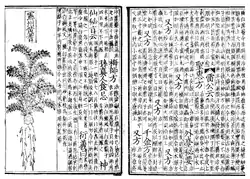
In late 10th century China the complete Buddhist canon Tripitaka of 130,000 pages was printed with blocks, which took between 1080 and 1102, and many other very long works were printed. Early books were on scrolls, but other book formats were developed. First came the Jingzhe zhuang or "sutra binding", a scroll folded concertina-wise, which avoided the need to unroll half a scroll to see a passage in the middle. About AD 1000 "butterfly binding" was developed; two pages were printed on a sheet, which was then folded inwards. The sheets were then pasted together at the fold to make a codex with alternate openings of printed and blank pairs of pages. In the 14th century the folding was reversed outwards to give continuous printed pages, each backed by a blank hidden page. Later the bindings were sewn rather than pasted.[16] Only relatively small volumes (juan 卷) were bound up, and several of these would be enclosed in a cover called a tao, with wooden boards at front and back, and loops and pegs to close up the book when not in use. For example, one complete Tripitaka had over 6,400 juan in 595 tao.[17]
Japanese woodblock prints

The earliest known woodblock printing dates from 764–770, when Empress Shotoku commissioned one million small wooden pagodas containing short printed scrolls—typically 6 cm × 45 cm (2.4 in × 17.7 in)—to be distributed to temples.[18] Apart from the production of Buddhist texts, which became widespread from the 11th century in Japan, the process was only adopted in Japan for secular books surprisingly late, and a Chinese-Japanese dictionary of 1590 is the earliest known example.
Though the Jesuits operated a movable type printing-press in Nagasaki, printing equipment[19] which Toyotomi Hideyoshi's army seized from Korea in 1593[20] had far greater influence on the development of the medium. Four years later, Tokugawa Ieyasu, even before becoming shōgun, effected the creation of the first native movable type,[19] using wooden type-pieces rather than metal. He oversaw the creation of 100,000 type-pieces, which were used to print a number of political and historical texts.
An edition of the Confucian Analects was printed in 1598, using a Korean moveable type printing press, at the order of Emperor Go-Yōzei. This document is the oldest work of Japanese moveable type printing extant today. Despite the appeal of moveable type, however, it was soon decided that the running script style of Japanese writing would be better reproduced using woodblocks, and so woodblocks were once more adopted; by 1640 they were once again being used for nearly all purposes.[21]
The technology quickly gained popularity among publishers, and was used to produce affordable prints as well as books. As a result, Japan began to see something of literary mass production and increasing literacy. The content of these books varied widely, including travel guides, advice manuals, kibyōshi (satirical novels), sharebon (books on urban culture), art books, and play scripts for the jōruri (puppet) theatre. Often, within a certain genre, such as the jōruri theatre scripts, a particular style of writing would come to be the standard for that genre; in other words, one person's personal calligraphic style was adopted as the standard style for printing plays.
Diffusion in Eurasia
The technique is found through South and Central Asia, and in the Byzantine world for cloth, and by AD 1000 examples of woodblock printing on paper appear in Islamic Egypt. Printing onto cloth had spread much earlier, and was common in Europe by 1300. "In the 13th century the Chinese technique of blockprinting was transmitted to Europe",[22] soon after paper became available in Europe. The print in woodcut, later joined by engraving, quickly became an important cultural tradition for popular religious works, as well as playing cards and other uses.[2]
Many early Chinese examples, such as the Diamond Sutra (above) contain images, mostly Buddhist, that are often elaborate. Later, some notable artists designed woodblock images for books, but the separate artistic print did not develop in China as it did in Europe and Japan. Apart from devotional images, mainly Buddhist, few "single-leaf" Chinese prints were made until the 19th century.
15th-century Europe
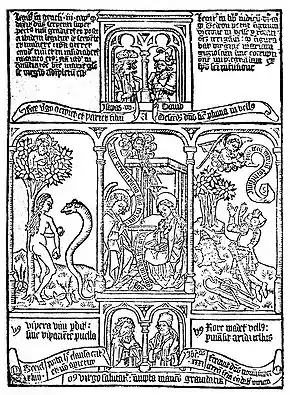
Block books, where both text and images are cut on a single block for a whole page, appeared in Europe in the mid 15th century. As they were almost always undated, and without statement of printer or place of printing, determining their dates of printing has been an extremely difficult task. Allan H. Stevenson, by comparing the watermarks in the paper used in block books with watermarks in dated documents, concluded that the "heyday" of block books was the 1460s, but that at least one dated from about 1451.[23][24] Block books printed in the 1470s were often of cheaper quality, as a cheaper alternative to books printed by printing press.[25] Block books continued to be printed sporadically up through the end of the 15th century.[23]
The most famous block books are the Speculum Humanae Salvationis and the Ars moriendi, though in this the images and text are on different pages, but all block-cut. The Biblia pauperum, a biblical picture book, was the next most common title, and the great majority of block books were popular devotional works. All block books are fairly short at less than fifty pages. While in Europe movable metal type soon became cheap enough to replace woodblock printing for the reproduction of text, woodcuts remained a major way to reproduce images in illustrated works of early modern European printing.
Most block books before about 1480 were printed on only one side of the paper — if they were printed by rubbing it would be difficult to print on both sides without damaging the first one to be printed. Many were printed with two pages per sheet, producing a book with opening of two printed pages, followed by openings with two blank pages (as earlier in China). The blank pages were then glued together to produce a book looking like a type-printed one. Where both sides of a sheet have been printed, it is presumed a printing press was used.
The method was also used extensively for printing playing cards.[26]
Further development in East Asia


In East Asia, woodblock printing proved to be more enduring than in Europe, continuing well into the 19th century as the major form of printing texts, especially in China, even after the introduction of the European printing press.
In countries using Arabic, Turkish and similar scripts, works, especially the Qur'an were printed from blocks or by lithography in the 19th century, as the links between the characters require compromises when movable type is used which were considered inappropriate for sacred texts.[27]
Nianhua were a form of coloured woodblock prints in China, depicting images for decoration during the Chinese New Year.
Types of wood used by the Chinese
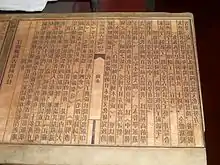
Dr. Henry, in his "Notes on the Economic Botany of China," refers to your wish to obtain specimens of the woods used in China for printing blocks. The name which the neighbouring city of Wuchang enjoys for the excellence of its printing work has led me to inquire into the woods used there, and I am sending you specimens of them by parcel post. The wood which is considered the best is the Veng li mu, which has been identified as the Pyrus betulcefolia, Bunge., and which grows in this Province. Slabs of this wood 1 ft. x 6 ins. x 1^ in. cost 150 cash, or about 5½.d. A cheaper wood generally used for printing proclamations is the tu chung mu. Eucommia ulmoides, Oliv., has been determined to be the tu chung mu. The tu chung here used is a native of this Province. A wood used in Kiangsu is the yin hsing mu, which is one of the names of the Salisburia adiantifolia. Boxwood, huang yang mu, is obtained from Szechuen, but only in small pieces, which are mainly used for cutting the stamps used for private seals on letters and documents.
In the third volume of the Japanese work, the "So Mokn Sei Fu," a drawing is given of the huang yang, together with a quotation from the Chinese Materia Medica, which speaks of the tree as growing an inch a year, except in these years which have an intercalary moon, when it grows backwards. From this it would appear to be a slow growing tree.
W. R. Carles, Esq., to Royal Gardens, Kew, dated Her Majesty's Consulate, Hankow, July 25, 1896.[28]
Materials other than paper
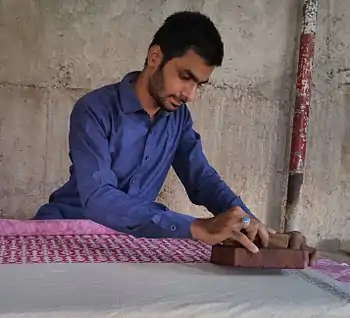

Block printing has also been extensively used for decorative purposes such as fabrics, leathers and wallpaper. This is easiest with repetitive patterns composed of one or a small number of motifs that are small to medium in size (due to the difficulty of carving and handling larger blocks). For a multi-colour pattern, each colour element is carved as a separate block and individually inked and applied. Block printing was the standard method of producing wallpaper until the early 20th century and is still used by a few traditionalist firms. It also remains in use for making cloth, mostly in small artisanal settings, for example in India.
William Morris was one artist who used woodblock printing to produce patterned wallpaper and textiles during the mid-to-late Victorian era Examples of Morris' work are housed in the Victoria and Albert Museum. The museum also holds a number of Morris' original woodblocks, which are still in limited use.
See also
References
- "21. Pre-Gutenberg Printing". www.schoyencollection.com. Schøyen Collection.
- Hind, Arthur M. An Introduction to a History of Woodcut, p64-94, Houghton Mifflin Co. 1935 (in USA), reprinted Dover Publications, 1963 ISBN 0-486-20952-0
- Shelagh Vainker in Anne Farrer (ed), "Caves of the Thousand Buddhas", 1990, British Museum publications, ISBN 0-7141-1447-2
- "Shi zhu zhai shu hua pu". Cambridge Digital Library. Retrieved 11 August 2015.
- Sickman, L.; Soper, A. (1971). The Art and Architecture of China. Pelican History of Art (3rd ed.). Penguin. ISBN 0-14-056110-2.
- Berner, R. Thomas (1997). "The Ancient Chinese Process of Reprography". Technology and Culture. 38 (2): 424–431. doi:10.2307/3107128. JSTOR 3107128.
- See (Bulliet 1987), p. 427: "The thesis proposed here, that the word tarsh meant "printblock" in the dialect of the medieval Muslim underworld".
- See (Bulliet 1987), p. 435: "Printing in Arabic appears in the Middle East within a century or so of becoming well established in China. Moreover, medieval Arabic chronicles confirm that the craft of paper making came to the Middle East from China by way of Central Asia, and one print was found in the excavation of the medieval Egyptian Red Sea port of al-Qusair al-Qadim where wares imported from China have been discovered. Nevertheless, it seems more likely that Arabic block printing was an independent invention".
- See (Bulliet 1987), p. 427: "Judging from palaeography and the eighth-century date of the introduction of paper to the Islamic world, Arabic block printing must have begun in the ninth or tenth century. It persisted into, but possibly not beyond, the fourteenth century"... "Yet it had so little impact on Islamic society that today only a handful of scholars are aware it ever existed, and no definite textual reference to it has been thought to survive".
- "Ashmolean − Eastern Art Online, Yousef Jameel Centre for Islamic and Asian Art".
- "Fifty Wonders" (PDF). Korean Hero. Archived from the original (PDF) on 2012-09-04. Retrieved 2013-01-29.
- Thomas Christensen (2007). "Did East Asian Printing Traditions Influence the European Renaissance?". Arts of Asia Magazine (to appear). Retrieved 2006-10-18.
- Pan, Jixing (1997). "On the Origin of Printing in the Light of New Archaeological Discoveries". Chinese Science Bulletin. 42 (12): 976–981 [pp. 979–980]. Bibcode:1997ChSBu..42..976P. doi:10.1007/BF02882611. ISSN 1001-6538. S2CID 98230482.
- North Korea — Silla Countrystudies.us accessed 2009-12-03; A History of Writings in Japanese and Current Studies in the Field of Rare Books in Japan Archived 2008-11-20 at the Wayback Machine – 62nd IFLA General Conference, Ifla.org, accessed 009-12-03; Gutenberg and the Koreans: The Invention of Movable Metal Type Printing in Korea, Rightreading.com, 2006-09-13, accessed 2009-12-03; Cho Woo-suk, JoongAng Daily Archived 2011-07-19 at the Wayback Machine, November 22, 2004, Eng.buddhapia.com, accessed 2009-12-03; National Treasure No. 126-6, by the Cultural Heritage Administration of South Korea (in Korean), jikimi.cha.go.kr, accessed 2009-12-28; National Treasure No. 126-6, by the Cultural Heritage Administration of South Korea (in Korean)
- Meggs, Philip B. (1998). A History of Graphic Design. John Wiley & Sons. p. 24. ISBN 0-471-29198-6.
- "Dunhuang concertina binding findings". Archived from the original on 2000-03-09.CS1 maint: bot: original URL status unknown (link)
- "Archived copy". Archived from the original on 2006-11-04. Retrieved 2006-12-06.CS1 maint: archived copy as title (link)
- "Archived copy". Archived from the original on 2006-11-04. Retrieved 2006-12-06.CS1 maint: archived copy as title (link)
- Lane, Richard (1978). Images of the Floating World. Old Saybrook, CT: Konecky & Konecky. p. 33. ISBN 1-56852-481-1.
- Ikegami, Eiko (2005-02-28). Bonds of Civility: Aesthetic Networks and the Political Origins of Japanese Culture. Cambridge University Press. ISBN 9780521601153.
- Sansom, George (1961). A History of Japan: 1334–1615. Stanford, California: Stanford University Press.
- Hsü, Immanuel C. Y. (1970). The Rise of Modern China. New York: Oxford University Press. p. 830. ISBN 0-19-501240-2.
- Carter p. 46.
- Allan H. Stevenson, The Quincentennnial of Netherlandish Blockbooks, British Museum Quarterly, Vol. 31, No. 3/4 (Spring 1967), p. 83.
- Master E.S., Alan Shestack, Philadelphia Museum of Art, 1967
- created 2003 – 2005 Early Card painters and Printers in Germany, Austria and Flanders (14th and 15th century). Retrieved 28 February 2010.
- Robertson, Frances, Print Culture: From Steam Press to Ebook, p.75, 2013, Routledge, ISBN 0415574161, 9780415574167, gogle books
- Royal Botanic Gardens, Kew (1901). Kew bulletin. LONDON: H. M. Stationery Office. p. 217. Retrieved 22 November 2011.
Dr. Henry, in his "Notes on the Economic Botany of China," refers to your wish to obtain specimens of the woods used in China for printing blocks. The name which the neighbouring city of Wuchang enjoys for the excellence of its printing work has led me to inquire into the woods used there, and I am sending you specimens of them by parcel post. The wood which is considered the best is the Veng li mu, which has been identified as the Pyrus betulcefolia, Bunge., and which grows in this Province. Slabs of this wood 1 ft. x 6 ins. x 1^ in. cost 150 cash, or about 5½.d. A cheaper wood generally used for printing proclamations is the tu chung mu. Eucommia ulmoides, Oliv., has been determined to be the tu chung mu. The tu chung here used is a native of this Province. A wood used in Kiangsu is the yin hsing mu, which is one of the names of the Salisburia adiantifolia. Boxwood, huang yang mu, is obtained from Szechuen, but only in small pieces, which are mainly used for cutting the stamps used for private seals on letters and documents. In the third volume of the Japanese work, the "So Mokn Sei Fu," a drawing is given of the huang yang, together with a quotation from the Chinese Materia Medica, which speaks of the tree as growing an inch a year, except in these years which have an intercalary moon, when it grows backwards. From this it would appear to be a slow growing tree. W. R. Carles, Esq., to Royal Gardens, Kew, dated Her Majesty's Consulate, Hankow, July 25th, 1896.
Works cited
- Bulliet, Richard W. (1987). "Medieval Arabic Tarsh: A Forgotten Chapter in the History of Printing" (PDF). Journal of the American Oriental Society. 107 (3): 427–438. doi:10.2307/603463. JSTOR 603463. Retrieved 2019-01-17.
- Lane, Richard. (1978). Images from the Floating World, The Japanese Print. Oxford: Oxford University Press. ISBN 9780192114471; OCLC 5246796
External links
| Wikimedia Commons has media related to Woodblock printing. |
- Centre for the History of the Book
- Excellent images and descriptions of examples, mostly Chinese, from the Schoyen Collection (Archived May 11, 2008, at the Wayback Machine)
- Fine example of a European block-book Apocalypse with hand-colouring
- Chinese book-binding methods, from the V&A Museum
- Chinese book-binding methods, from the International Dunhuang Project
- Chinese woodblock prints from SOAS University of London
- "Multiple Impressions: Contemporary Chinese Woodblock Prints" at the University of Michigan Museum of Art
- American Printing History Association—Numerous links to Online Resources and Other Organizations
- Wood-Block Printing, by F. Morley Fletcher, Illustrated by A. W. Seaby at Project Gutenberg
- Block printing in India
- Prints & People: A Social History of Printed Pictures, an exhibition catalog from The Metropolitan Museum of Art (fully available online as PDF), which contains material on woodblock printing
- The History of Chinese Bookbinding: the case of Dunhuang findings
- Video: Block-printed wallpaper, a video demonstrating printing of multicolored wallpaper with a press, using blocks produced by William Morris
